As you may have figured by now, we are quite settled here; we are one month into our three month internship at Koinonia Farm. Lauren, Lindsay, and I have shared stories, estranging encounters, poems, and even the smallest moments of light, all centered around this place; though, we have yet to share where its identity lies—identity in the past and present. So, this is for all of those who have heard us say “Koinonia,” those who have tried to spell it, those who have tried to pronounce it, and the rest of those who want to know…”Is it really just a nudist colony set amidst the red clay roads in southwest Georgia?”
Koinonia [pr. Koy-nohn-ee-ah] (origin, Greek) :: communion, commune
Koinonia’s mission statement:
“We are Christians called to live together in intentional community sharing a life of prayer, work, study, service and fellowship. We seek to embody peacemaking, sustainability, and radical sharing. While honoring people of all backgrounds and faiths, we strive to demonstrate the way of Jesus as an alternative to materialism, militarism and racism.”
Wait a hot minute. “We are Christians.” Who sighs with relief from a sudden, unexpected sense of solidarity overwhelming them, and who cringes, gritting their teeth at my mention of religion? Go ahead, grit your teeth. But, bear with me. How often does “Christians” appear with the same language as “sustainability,” “radical sharing,” “alternative to militarism?” That has to strike some chord of curiosity. For my friends and mentors that don’t hold this faith, I know for a fact that many of you cherish personal values with some regard to social justice, ecological resilience, and/or economic vitality. Thus, I very well think my experience in this community, despite being identified as Christian, shares common ground with what you believe, study, teach, or how you seek to live. For those of you that I do not know—yes, we have poetry enthusiasts, a Romanian, and friends of friends following our blog—conversations centered about “new monasticism” are liberating “the church” around the world. Suddenly, it is a lamp that I will put on a stand. So consider this my input to the conversations. I hope you find it worth reading and sharing…or at least may it be a conversation piece at your next potluck. For today (possibly more than ever), everyone of any or no belief should be working together for a “heaven” on earth, painted with all of our individuals stories to create a whole picture.
.
And if you are still gritting their teeth, a DISCLAIMER:
Speaking about my faith has always been an EXTREMELY vulnerable subject for me; any mention of it in the classroom would leave me feeling like I was sitting there amidst everyone, stark naked. But as friends/peers/mentors/professors/strangers who have lived to seek equality, live honestly, and respect anyone IN SPITE of her/his beliefs, I hope that you can respect the history of my own faith that I want to share with you and that you would also receive it with openness—despite the word “Christian” appearing. I need this. For, there’s even more substance to my creed: While in almost all Appalachian State University circles I felt respected for my morals/ethics, never did I feel like this respect was for their rootedness in Christianity. In fact, any association of such morals/ethics with a Christian religious figure, like Jesus, seemed like grounds for being written-off by those opposed or once-hurt by organized religion…surely Jesus cannot be associated with today’s principles of justice and sustainability. And more: while my peers directly or indirectly renounced Christianity in discussion, many revered religions with doctrine for peace and equality (such as Buddhism), within the same discussion. Could there not be a common root, or purpose to live for, not matter one’s understanding of “God?” Well, I understand: first, Christian faith is often spoken of without much graciousness; second, the mainstream, but misconstrued, personification of [American] Christianity has really made it difficult for me to find mutual identity within this faith.
So for the sake of evading judgment from peers in those aforementioned spaces, my faith often went unmentioned, especially in Sustainable Development classes and social justice circles. I preferred to only live it, defending not, saying nothing. Now, by habit, I could omit this vocabulary below entirely, but then I would be sacrificing a large portion of my own authenticity for the sake of popular comfort. And frankly, I want to be in a figurative place where I can call myself Christian and not quietly glance around to see who cringed. So I will ask you, would you sacrifice your personal convictions for the sake of your voice always being music to another’s ear? I hope not, my friends! So, I may use some jargon below in my description of Koinonia that even I still struggle to say; however, I am learning how to share what I believe in the context of the Bible and not what a televised body of politicians, preachers, and other instigators have told me to say about our “shared” faith. Basically, Jesus did not live only for the white and American and privileged. So if this makes any sense or you want to make sense of it, please read on!
.
Koinonia Farm
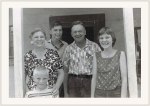
Koinonia Farm was founded in 1942 by two families, Clarence and Florence Jordan and Martin and Mabel England, though it was steered through tumultuous cultural and community turmoil by a single man’s vision that went on to influence thousands of lives. Clarence Jordan (pronounced “Jer-din”), an UGA graduate in agriculture but a Doctor of Theology (greek and new testament), wanted to live in a way that demonstrated a life dedicated to living out the way of Jesus…in the 1940s, in southern Georgia. Based on stories from his childhood, I reckon seminary was not the only experience that determined his theology. In a journal entry, he recalled hearing “Jesus Loves the Little Children” and making the connection that it is sung to the same tune as an American battle hymn. Not only do I find significance in the way he recognized such discrepancy as a young child, questioning the ethic of the song in his formative sunday school years, but also by the way he made a conscientious objection to it. His young adulthood was filled with similar instances, instances of objection to the so-called “Christian ethic” he witnessed. Eventually, he came to this conclusion: rather than imaging Jesus as a religious man roaming in the Middle East in biblical times, he imagined him here living amongst the most marginalized people, seeking full equality on the dirt clay roads of Americus, GA, pre-U.S. civil rights. Simply put, he believed that Jesus (regardless of your understanding of him as being the son of God or not) was not a religionist, but a revolutionary worth following. Further, the Bible is not a “diagrammed formula,” but a collection of stories that depict a spirit by which we can live accordingly. So from 1942 onward, Clarence sought to live this VERSION of the Gospels and along the way he wrote and preached his depiction “The Cotton Patch Gospels.” Such were the means to share and invite others to live in the same spirit. Yet, Jordan and others associated with his demonstration plot in Americus, Georgia were never mentioned in a U.S. history class or any lecture on Civil Rights advocacy in the South…in my experience, at least.
From its beginning in 1942, this farm was a “demonstration plot” for racial equality and conscientious objection. “Koinonia,” named for it’s meaning of “communion,” was a farm where black and white both lived, worked, and ate together with functional harmony. More than an issue of black and white, Conscientious Objectors (C.O.’s) sought refuge at Koinonia, shamed by the majority of society as those unwilling to fight in “God’s war” for their homeland. With such diverse presence, Clarence “was determined to fight fascist-like oppression in Georgia with something that Southerners were almost as familiar with as they were their guns: Christianity.” For, Clarence wanted lives in the Southeastern U.S. to be changed by grace, not laws. In this case, he would question which is worse, segregation or forced integration? Though he was not ignorant to the risk their demonstration plot would face. For indeed, local people found this conglomeration of people enraging, and conflict escalated as word of the counter-culture lifestyle here reached further out of town. Regional church officials suggested that Koinonians were “ill-advised.”

One of my favorite Koinonia-congregation conundrums involved Florence Jordan representing the whole Koinonia community at a Rehoboth Baptist Church in 1950: the deacons held a business meeting to decide if Koinonians should be asked to leave the church as they caused “disunity” in the congregation and questioned the Baptist doctrine and policies. When the deacons’ recommendations were read aloud, suggesting that “representatives of [Koinonia] have brought people from other races into the services of the Rehoboth…and have disrupted the Christian unity and spirit which had previously prevailed,” Florence stoodup and said, “I move that the recommendations of the deacons be accepted as read.” There was “gaping, confused silence,” as she basically pleaded guilty. Florence later reflected, “They supported the motion but they didn’t want to vote with me.”
At this point, most members stopped seeking discipleship in area churches until a hopeful day when reconciliation was desired though a select few still persisted in finding a congregation that considered themselves akin to Koinonia’s ethics. These few found home in the Episcopal church, though even this congregation became afraid that their wooden church would be targeted by the KKK. So the “church” was no longer a sanctuary for Koinonians; they sought spiritual direction from one another, affirming that their pursuit for justice was indeed righteous. However, opposition continued to strain the community, growing more violent by January of 1957. The KKK and anonymous others repeatedly rode by with armed motorcades, shot at their houses day and night with machine guns, beat up community members in town, and spoke endless threats. They deliberately decided to remain unarmed by have a rotating watchman at the road, thinking, “No one will shoot a man or woman only armed with a flashlight. One night, the flashlight was shot right out of farm resident John Eustice’s hand. In many cases, Koinonians woke up to 300 of their fruiting trees chopped down, the beehives destroyed, their farm stand bombed, the welcome sign burned down. On Easter Day, a large motorcade passed and Koinonian children found a piece of a church bulletin on the road side: on one side it read, “Blessed is the man whose words and deeds are day by day and every day a witness to the living and loving Lord,” while on the opposite side, “Get out, You Mongrels!” was scribbled. Koinonian children were banned from the Americus public schools or were removed by their parents for safety’s sake. Farm product boycotts instigated by the KKK put the farm in a financial crunch, growing more severe as not only local customers participated but general suppliers also cut their ties with Koinonia out of fear from public pressure. There was support, though few and far between, from sympathetic intentional communities in the north and Koinonia product customers around the U.S. The mail-order farm products and promisory notes (to cover the farm’s insurance, which was all repealed in 1957) from over two thousand supporters actually became the bread-winners when the local market for their meats, eggs, nuts, and sweets was staunched by the boycott. But despite being asked to leave the community, the Jordans and most everyone remained here, painstakingly deciding that to live the faith they claimed, they had to demonstrate and advocate for justice by living it together…even if it meant dying in such a pursuit. However, not a single person was killed, despite trace bullets riddling through car and house walls, right past their heads on more than one occasion.
Jordan is now publicly honored as a peacemaker who believed not in creating public disturbance for one’s cause, but rather for standing one’s ground for justice—simply living out a Christian life with as little contradiction as possible. When asked if he had ever been on a freedom walk, Clarence commented, “No, but I always walk freely.” While honor today may seem obvious, it has come from a long period of redemption, for at his death in 1969, he was still a man whose life was rejected by even the coroner. Members wondered how Koinonia would continue without his spiritual guidance, but much direction came from Florence and the Fuller family, and thus the Koinonia spirit continued. The recreation here led to the creation of Habitat for Humanity, the Fuller Center for Housing, Jubilee Partners (a refugee living community rooted in agriculture to ease transition into American society), the Prison Project, and many other community-based initiatives. Of course, the community has had its issues. In the 1990s, there was a huge transition in mission, involving a new non-profit structure which led to financial squandering and residential flight. Koinonia then faced a period of questioning, for leadership, spiritual direction, and financial stability.
Today, this community has come full circle; while still centered around partnership, it has swung back to its agricultural roots under the guidance of many “Stewards” (long-term collaborators), which includes Director Bren Dubay; a courageous novice; and contributing interns. These members and interns today have the conviction that living out Christian ethics to seek a “kingdom on earth” means reconciling and living with the land, not just people, as they always have. They asked, “How is a sign with a skull and cross bones hung in the orchard inviting?” Since then, they have made slow changes for agrarian reconciliation, like using biological pest control in the pecan orchards (the main crop) rather than conventional pesticides; using fair trade ingredients in the chocolate made for their product industry; involving a homeschool cooperative to peak youth interest in agrarian life; and using a permaculture model and attitude for developing the farm’s practicality within this plot. While membership is far less today than its peak of 42 in the 1950s , those here embrace each others’ expression of the individual and collective faith, and hope that their hospitality is inviting for others to visit or join. For, in continuity with Clarence’s vision, all are invited to the table for “koinonia.”
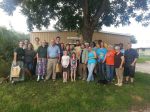
With so many people engaged here, Koinonia takes on more than the meaning of “communion.”
Norris excitedly says it is, “1324 GA Hwy 49 South—Americus, GA.”
Hannah, our German roommate uses a translation website that defines it as, “We can be human only in fellowship, in community, in koinonia, in peace.”
And I? For now I am calling it “taking root.”
.
So, if you cannot tell, I love this place. I wake up at dawn, awaiting the sun—which tells me I will face joys and tribulations this day. And then I go to sleep by the sweet lullaby of the Milky Way, at the brightest I’ve ever felt it. Everyone here has such rich heritage, laden with joy and sorrow and despite their nerves, they still chose to share their story with us. Then they listened to my story. There are two bright-eyed, tree-climbing, swing-setting children that ask me, “Can you play with us?” and despite how tired I am or how bad of a headache I have, I can hardly ever say “no, not today.” The pigs are happy to eat the weeds I pull, in preparation for a wintering garden. We eat Malabar spinach and sweet potato greens in our salad at lunch. We have pickle parties, complete with grape leaves. I find focus in daily thought and prayer in both solitude and community, a sounding bell reminding me three times a day to pause for this (unless we interns forget to ring the 8 o’clock bell…which we often do). I get to read for discussion and my sole pleasure. We read short stories aloud on our porch and when the light is on, the community interns know to come over for reindeer games like “telephone-pictionary,” “writey-drawey,” “a fat lady sings in a garden,” or what have you. And what would it be without Capture the Flag at “O’dark:30?”
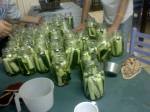
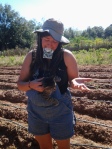
The daily expressions of life here at this plot bring us consolation and even desolation, and these, my sisters and brothers, are what we find worth sharing with you as we live in koinonia.
In the meantime, DELIGHT in your own celebration of authentic community!
Peace I leave with you; my peace I give to you. Jaimie
*All historical facts were compiled from various sources: Dallas Lee’s The Cotton Patch Evidence, the film “Briars in the Cotton Patch,” our Study Sessions on Koinonia Farm, and www. Georgiaencyclopedia.org.
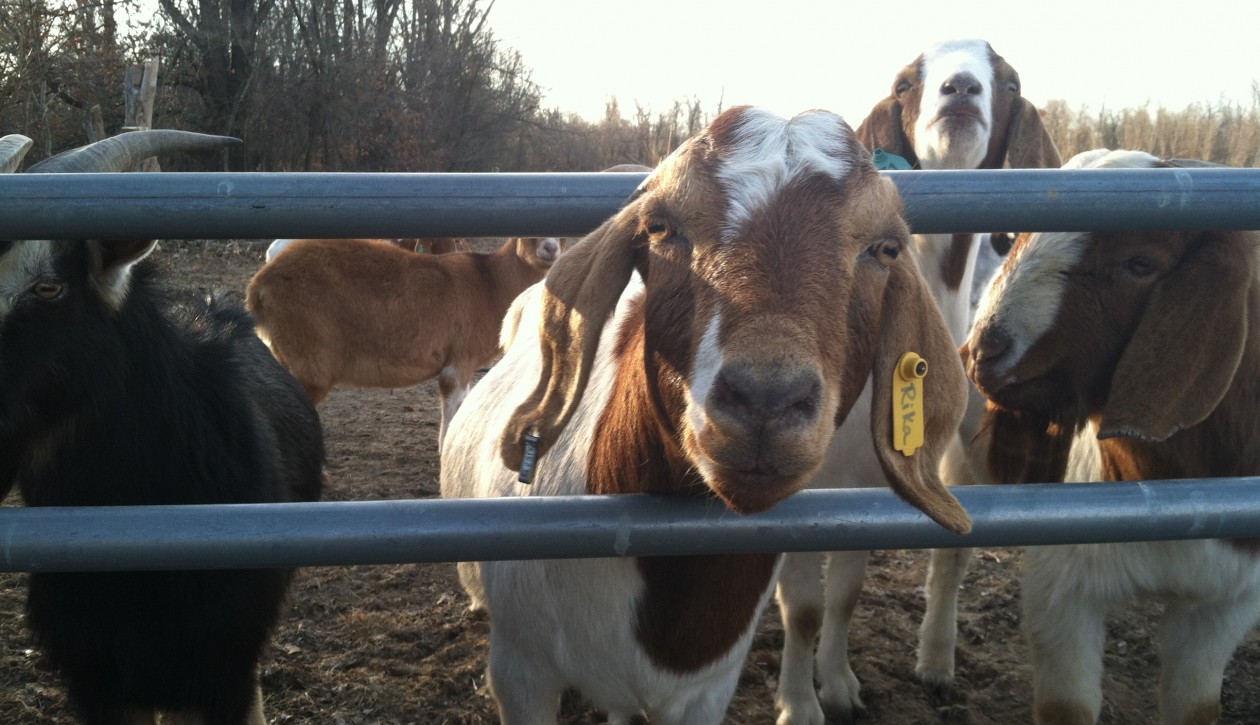
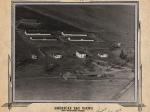
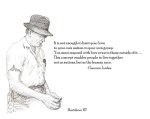
If anyone is interested in visiting or arranging a group to visit (in which you can stay in the guest house, join us for community meals, tour the farm, pick up sticks, work in the pecan plant, etc, go to): http://www.koinoniapartners.org. If you’d like some tasty products like fair trade chocolate pecan bark, roasted pecans, that Lauren, Lindsay, or I may have very well packaged ourselves, check out the catalog: http://www.koinoniapartners.org/catalog/index.html
I just read your Blog post containing Koninoa’s history in the late fiftys with the KKK and other community bigots. It reminded me of those times and my experience during that time. I dug out a I appreciated your Post!
A piece I wrote several years about one my experiences during the fifties..
When Arthur Was Not Well
In some ways this event seems like yesterday and in other ways like several lifetimes ago. It was in the mid fifties.
My mother and I sat on the side porch, she seemed troubled and in response to my question as to what was wrong, she said soulfully, “Arthur is not well.”
Arthur was Clevie’s son. Clevie, our black maid, had been with us for eighteen years, after she came as a young girl with my parents from Shelby NC to Reidsville where my dad was to manage a new Penney store. She was my sister’s and my nursemaid, and afterwards my parent’s maid.
“So what’s wrong with Arthur?” I asked; thinking surely Arthur was in the end stages of some horrible disease.
“I’m not sure, but it’s about to do his mother in.”
Here was the first sign that Arthur’s illness probably wasn’t bacterial or viral in nature. Doing one’s mother “in” was usually referred to diseases with behavior related symptoms.
“What is he doing I asked?” giving away my suspicions.
“Well, he’s gotten mixed up with the wrong crowd in Greensboro and he’s acting like a big fool there. A lot of coloreds are marching in the streets and going where they are not wanted. If Arthur doesn’t watch out he’s going to get himself killed and there is nothing Cleive can do about it.”
My mother lectured on, listing Arthur’s dreaded symptoms.
“Just yesterday he and a bunch of them marched in and sat at a lunch counter reserved for whites** at Walgreens drug store. Arthur knows better than that.”
Yes, this was the summer that Arthur Crisp was not well, not well at all. His strange illness had soon infected the entire country and changed it forever.
I didn’t see Arthur again for some thirty years when I went with my mother and sister to Clevie’s funeral in her native Shelby home. We saw and talked to Arthur and his wife after the funeral. Arthur may not have been completely well but it seemed that he was making a pretty good recovery.
I think we all were.
* A pivotal week for the Civil Rights Movement
JMcB
Jerry, this was a wonderful story and I am so happy you shared it. I don’t know the in’s and out’s of this blog business as well as Lindsay does, so I just now discovered this comment! Can I share this further on the blog?
Peace.
Jaimie
SHARE AWAY!! It was for real.